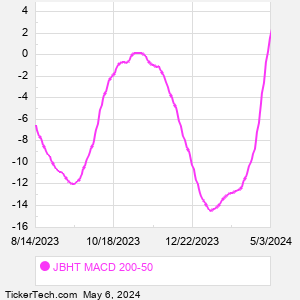J.B. Hunt Transport Services is a holding company. Through its subsidiaries, Co. is a surface transportation, delivery, and logistics company. Co.'s service offerings include transportation of full-truckload containerized freight, which it directly transports utilizing its Co.-controlled revenue equipment and company drivers or independent contractors. Co. has arrangements with the North American rail carriers to transport freight in containers or trailers, while it performs the majority of the pickup and delivery services. Co. also provides customized freight movement, revenue equipment, labor, systems, and delivery services that are tailored to meet individual customers' requirements.
When researching a stock like J.B. Hunt Transport Services, many investors are the most familiar with Fundamental Analysis — looking at a company's balance sheet, earnings, revenues, and what's happening in that company's underlying business. Investors who use Fundamental Analysis to identify good stocks to buy or sell can also benefit from JBHT Technical Analysis to help find a good entry or exit point. Technical Analysis is blind to the fundamentals and looks only at the trading data for JBHT stock — the real life supply and demand for the stock over time — and examines that data in different ways. One of those ways is to calculate a Simpe Moving Average ("SMA") by looking back a certain number of days. One of the most popular "longer look-backs" is the JBHT 200 day moving average ("JBHT 200 DMA"), while one of the most popular "shorter look-backs" is the JBHT 50 day moving average ("JBHT 50 DMA"). A chart showing both of these popular moving averages is shown on this page for J.B. Hunt Transport Services. Comparing two moving averages against each other can be a useful visualization tool: by calculating the difference between the JBHT 200 DMA and the JBHT 50 DMA, we get a moving average convergence divergence indicator ("JBHT MACD"). The JBHT MACD chart, in conjunction with the chart of the moving averages, basically helps in visualizing how the moving averages are showing convergence (moving closer together), or divergence (moving farther apart). |



